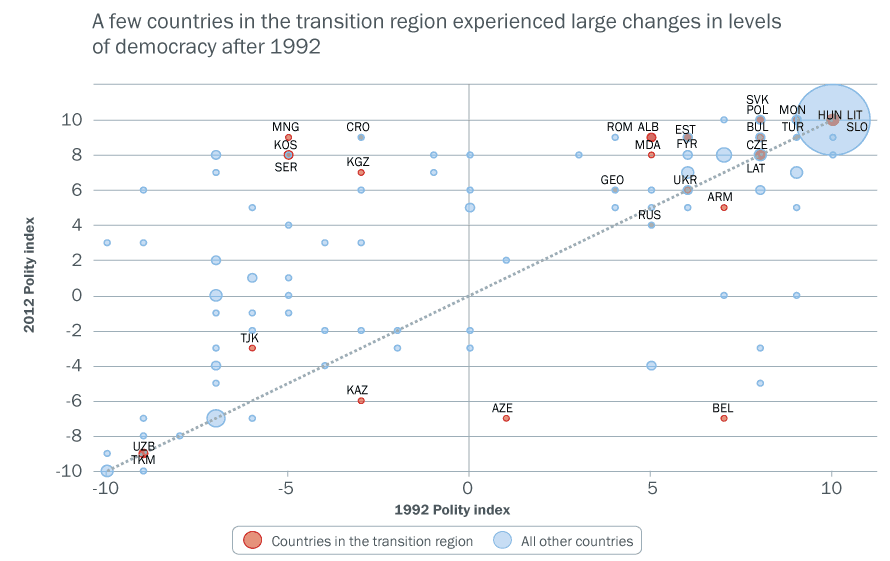Markets and democracy
Reform and democracy
- Details
- Markets and democracy
The collapse of the Soviet Union and communism was a political “big bang” moment, giving countries in the transition region an opportunity to recreate their political institutions. To what extent, and at what speed, should this result in the development of stable democracies? The literature cited in the previous section offers three main propositions.
First, one would expect some correlation between initial political institutions and the underlying social and economic conditions of each country. Countries with economies based on manufacturing and a relatively well-educated population would tend to establish and consolidate democratic institutions. By contrast, agrarian or extractive economies would typically find it more difficult to adopt democratic systems.
Second, as economies develop and grow, democracy would be expected to take hold. However, given the time lag between economic development and democratisation, there would probably be relatively few immediate transitions to full democracy in the first 10 to 20 years after the beginning of post-communist economic recovery.
Third, one would expect the speed of transition to market economies – particularly in the first few years after the collapse of communism – to be a predictor of the countries’ propensity to democratise, or at least to develop nascent democratic systems with some degree of stability. Adopting liberal market institutions quickly would make it less likely that a political elite could take control of large parts of the economy (either directly or in collusion with specific economic groups or firms) and block the introduction of democratic mechanisms, or distort them, to preserve their political control and economic rents.1
These propositions are supported by the evidence. The political shock of 1989-92 led to a wide divergence in political systems across countries, followed by considerable stability in both the level of democracy and free markets over time (see Chart 2.2).
In central European countries – which were the most advanced economies in the former Soviet bloc and had the shortest period under communism (imposed from outside), highly educated populations, but few natural resources – political institutions were democratic by 1991 and reached the level of advanced Western democracies by the early 2000s.
Conversely, in eastern Europe and the Caucasus (EEC) and Central Asia, democracy generally started from a low level and has made uneven gains. In many cases, this reflects the power of the old elite (or part of it, combined with new political entrepreneurs), who ended up with control over strategic sectors of the economy or the post-communist state itself. Democratic progress has been particularly subdued in most countries in resource-rich and agrarian Central Asia.
Several countries in south-eastern Europe (SEE) have made significant progress towards democracy over the 20-year period since 1992 (see Chart 2.3, which compares Polity scores in 1992 and 2012). The constituent states of the former Yugoslavia started out with authoritarian or weak democratic systems, but by 2000 had become full democracies.
These transitions partly reflected external shocks (as in the case of the Milošević regime in Serbia, whose end was accelerated by the Kosovo war), but also domestic pressure for change (as in Croatia). Similarly, the Kyrgyz Republic experienced a home-grown democratic transition in 2010. However, other countries, such as Belarus, slid down the democracy scale in the 1990s (see case study later in this chapter).
This leads us to the core question in this chapter: what drives these changes in democracy over time, and what explains the differences in outcomes across countries? To what extent is there systematic empirical support for the drivers of democracy discussed earlier in this chapter?
- See Hellman (1998). [back]














